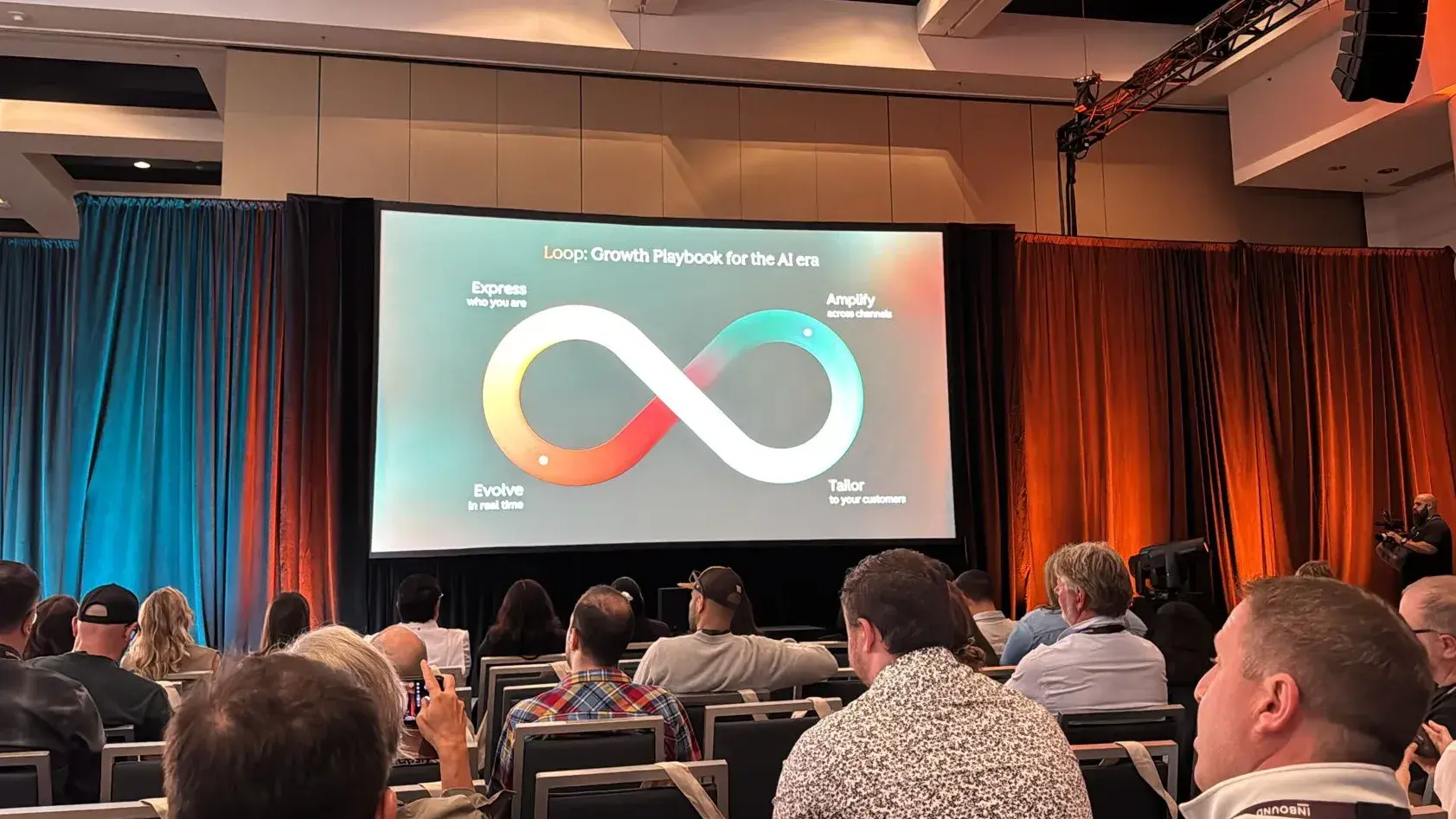The marketing world is on the move. Thanks to generative AI, we can produce blogs, emails and social posts in seconds. But how do you maintain the real connection with your target audience? During INBOUND 2025, HubSpot presented an answer to this challenge: Loop Marketing. This new strategy promises to provide the marketing funnel with fresh momentum in an era filled with AI and automation. Loop Marketing embraces the power of AI, but at the same time commits to human authenticity and continuous improvement. In this blog, we dive into what Loop Marketing entails, why it's relevant right now, and how to practically apply the four phases (Express, Tailor, Amplify, Evolve).
What is Loop Marketing?
Simply put, Loop Marketing is a marketing strategy that acts as a continuous improvement cycle. Instead of a linear funnel or separate campaigns, you think in recurring loops where each cycle learns from the previous one. HubSpot unveiled this concept at INBOUND 2025 in response to the rise of AI and changing customer behavior. Marketers now have access to powerful AI tools to analyze data and generate content, but without a human, authentic story, marketing quickly risks becoming generic. Loop Marketing therefore combines the best of both worlds: the scalability of AI-driven automation and the authenticity of a distinctive brand experience. The goal is to continuously create "momentum" in your marketing funnel.
Specifically, Loop Marketing consists of four phases: Express, Tailor, Amplify and Evolve. Each phase has its own purpose and deployment of AI tools, but together they form a continuous cycle. Below we discuss these phases step by step, with their objectives and how to implement them.
Phase 1: Express - Create your unique brand style with deep customer insight
The first phase lays the strategic foundation for all subsequent steps. Producing a lot of content quickly is not the problem these days. What is more challenging is the consistency and uniqueness of your message. Express is all about capturing a unique brand style and story, fueled by thorough understanding of your target audience. The idea is that all content (including that generated by AI) has a recognizable, authentic voice that resonates with what your customers care about.
Goal: Formulate a clear brand identity and message based on data about your target audience, so your content creation is aligned with your brand values and customer needs from day one.
Implementation examples:
-
AI-driven audience analysis: Use AI tools (such as HubSpot's Breeze assistant) to deeply analyze your CRM data and identify patterns or characteristics of your best customers. This will help you discover what pain points, language and content resonate with your audience.
-
Develop brand style guide: Organize workshops (internally or with a partner) to translate the insights from the data into a Brand Style Guide - a guide that establishes the tone, style and guidelines for all your content. This ensures that every blog post, email or AI-generated text exudes the same authentic brand voice.
Case study: Say you discover through AI analysis that your B2B customers respond positively to an informal, humorous tone-of-voice in communications. In the Express phase, you capture this in your brand style. Thus, all content - whether written by a copywriter or an AI tool - will contain that distinctive, humorous tone and make your brand your own.
Phase 2: Tailor - Make the story personal
With a strong brand foundation in place, it's time to tailor your story to each lead. Tailor focuses on personalization: making sure each prospect feels like your message was created specifically for them, rather than a generic mass expression. In the AI era, customers increasingly expect experiences tailored to them, similar to how Netflix or Spotify personalizes content. Tailor makes this possible by harnessing the power of your data and AI.
The goal: create highly targeted, contextual experiences for each lead with the help of AI, so that communication feels truly personalized. Not just in name, but in content and timing.
Implementation Examples:
-
Smart data enrichment & segmentation: Let AI help you learn more about your leads. For example, tools can add public information to contact profiles or analyze behavioral indicators. Based on this, segment your database by interests or buying intent. Consider differentiating leads that are early in the exploratory phase vs. leads with clear buying signals.
-
Dynamic content and emails: Set up personalized content that automatically adapts to the recipient. In HubSpot, you can work with smart content and dynamic email templates that vary based on someone's industry, previous interactions or purchase history. Someone who has already purchased product X thus gets a different message than someone new.
Case study: A visitor downloads an e-book on your site. Instead of putting him/her in a general nurture flow, you enrich the profile with AI (e.g. company size, sector) and send follow-up emails with cases and tips exactly for that sector and challenges. The tone remains consistent with your brand thanks to the Express phase, but the content is more relevant on a personal level - increasing the chances of conversion.
Phase 3: Amplify - Expand your reach through trusted channels and voices
You have strong content and a personalized approach; now it's important that your message actually reaches your intended audience. Amplify focuses on scaling your visibility through the right channels and through trusted voices in the marketplace. In a time where B2B buyers orient themselves on multiple platforms and value peer reviews and recommendations, you need to be present where your target audience is active and with a credible message.
Goal: Increase your brand's discoverability and credibility by being present on various, relevant channels with a consistent, recognizable message. Make sure potential customers find your content where and when they are looking for information, preferably provided by sources they trust.
Implementation examples:
-
Channel selection based on data: Use AI insights to find out what online places your target audience is located and searching. Perhaps it turns out that LinkedIn and niche forums are more effective for you than Facebook, or that certain search terms via Google generate a lot of traffic. Then focus your content strategy on these channels.
-
Engage trusted voices & AI helpers: Enlist "trusted voices" to increase your reach. This can be done in two ways: first, through Customer Agents (AI chatbots or virtual assistants) that answer website visitors' questions 24/7 in a helpful, brand-compliant way; second, through creators/influencers in the industry. Work with industry experts or satisfied customers who are willing to share your content or act as ambassadors. Their involvement adds credibility to your brand.
-
Consistent omnichannel campaign: Ensure an integrated campaign approach across all chosen channels. HubSpot's tools make it easier to schedule and monitor messages across a variety of platforms. Importantly, the message and tone-of-voice should be recognizably the same everywhere - from your email newsletter to your LinkedIn posts and webinar. This consistency builds trust with your audience no matter where they encounter you.
Case study: Suppose you target IT executives. Through data, you discover that they are active on LinkedIn and like to read independent product reviews. In the Amplify phase, for example, you will do a LinkedIn Live session together with a renowned IT blogger (trusted voice) and arrange for an AI chatbot on your website to answer technical questions directly. You also publish a series of blog articles optimized for search queries that IT managers type into Google. In this way, you increase the chances that your solutions will reach the target audience through various avenues.
Phase 4: Evolve - Optimize and learn in real time
The final phase, Evolve, is all about continuous improvement and acceleration. Whereas traditional marketing campaigns are often evaluated only after the fact, Loop Marketing is committed to real-time adjustment. In Evolve, you embrace a culture of experimentation: you use data and AI to gain insights at lightning speed into what works and what doesn't, and adjust your approach immediately. This keeps your marketing strategy agile and progressive.
Goal: Build a process of continuous optimization, in which you can adjust your campaigns as they run with the help of AI and live data. As a result, you maximize returns and respond quickly to changing customer behavior or market conditions.
Implementation - examples:
-
Predictive analytics: Deploy AI tools to make predictions about campaign results before and during action. For example, predictive analytics can indicate which email subject line is likely to get the highest open rate - even before you send the mailing. This helps you make data-driven choices.
-
High-velocity experiments: Run small-scale experiments continuously. For example, instead of running one large campaign for three months, test variations (A/B tests, content versions, audience segments) weekly. Thanks to AI and automated testing frameworks, you can run as many as 4-6 experiments per month and learn incredibly quickly what resonates with your audience.
-
Real-time monitoring & adjusting: Set up a live dashboard that tracks performance (website traffic, conversions, engagement) during campaigns and let AI look at the patterns with you. See halfway through a webinar campaign that a particular ad is underperforming? Then you pause or change it immediately, instead of only concluding after the event what could have been done better. This continuous feedback loop ensures that your marketing never stands still.
Case study: You launch a new product campaign. Halfway through the first week, your real-time dashboard shows that a lot of traffic comes through a blog article, but the corresponding landing page converts poorly. Through Evolve actions, you immediately set up an additional A/B test for the landing page and use an AI tool to generate alternative copy that better matches visitors' expectations. Within days, you see the conversion rate increase, even during the campaign. An improvement that otherwise wouldn't have happened until after the campaign is over.
By going through these four phases, you respond to the main trends in modern marketing. Authenticity (Express) ensures a credible story in a time of AI content overload. AI-driven personalization (Tailor) makes prospects feel truly engaged. Your presence on the right channels with the right influencers (Amplify) aligns with customers' changing orientation behavior. And a culture of continuous experimentation (Evolve) ensures that you always stay one step ahead of the competition.
Doing more with AI and Loop Marketing?
Bright Digital believes that technology is only truly powerful when combined with a human, authentic story. Loop Marketing is a great example of how to enhance inbound marketing with AI without losing the human touch. As a B2B marketer, would you also like to do more with AI and HubSpot to take your marketing to the next level?
Our HubSpot experts are here to help you explore the possibilities together. Whether it's setting up a strong Express phase (think AI analytics and a brand workshop) or fine-tuning real-time dashboards in the Evolve phase. We'd love to help you get started. Contact Bright Digital for a no-obligation consultation or demo.






